|

Wouldn’t it be great if you could make it simple and easy to maintain your target body weight? The great news is that there are a few basic principles at the core of each weight maintenance
program that can work for everyone. Whether you want to maintain your current weight or trim a few pounds, here are a few tips to stay healthy and on target.
Let’s talk about the basics first. The human body is always burning calories, even while sleeping. Calories burned at rest are used to complete essential functions, such as cellular respiration, maintaining body temperature, delivering blood and nutrients to tissue, and repairing cell damage.
The amount of calories your body burns at rest in one day is known as your Basal Metabolic Rate (BMR). Each individual has a unique BMR because the rate is based on a number of variables, including age, genetics, gender, weight, body fat, and diet.
FORMULA ONE: Basal Metabolic Rate (BMR) is the amount of calories an individual will burn at rest in one day. Use the following formulas to calculate BMR for Men and Women.
BMR FOR MEN = 66 + (6.23 x Weight) + (12.7 x Height) - (6.76 x Age)
BMR FOR WOMEN = 655 + (4.35 x Weight) + (4.7 x Height) - (4.7 x Age)
(Note: Weight in pounds / Height in inches / Age in years)
To calculate how many calories you burn in one day— a value known as your Total Daily Energy Expenditure (TDEE) — you will also need to factor in the amount of physical activity you get during the week. If you want to maintain your current body weight, you will need to consume no more or less than the number of calories you burn each day.
FORMULA TWO: Total Daily Energy Expenditure (TDEE) is the amount of calories an individual must consume daily to maintain their current body weight. Use the following formulas to calculate TDEE based on the amount of exercise completed each week.
SEDENTARY = BMR x 1.2 (Little or no exercise / Desk job)
LIGHTLY ACTIVE = BMR x 1.375 (Light exercise / Sports 1-3 days/wk)
MODERATELY ACTIVE BMR x 1.55 (Moderate exercise / Sports 3-5 days/wk)
VERY ACTIVE BMR x 1.725 (Hard exercise / Sports 6-7 days/wk)
EXTREMLY ACTIVE BMR X 1.9 (Hard daily exercise / Sports and physical job / 2x day training, i.e. marathon, contest, etc.)

TIP ONE: To Lose Weight, Eat Less and Burn More
In order to lose weight you must have a calorie deficit,which means you need to burn more calories than you eat. There are approximately 3,500 calories in one pound of stored body fat. To lose one pound, you will need to have a deficit of 3,500 calories. The best goal is to have a small calorie deficit each day. If you calculate how many calories your body requires each day (TDEE), experts recommend subtracting 15 to 20 percent from that total to determine a healthy estimate for daily calorie consumption. Results should be monitored and adjusted according to each person’s metabolism.
TIP TWO: Use Weight Training to Increase Metabolic Rate
One simple way to increase your BMR is to increase your lean body mass through resistance training. Fatty tissue is easy for your body to maintain, muscle is not. Muscle demands high calorie consumption to circulate blood, exchange gases, restore nutrients, and regulate temperature. If you increase your muscle mass and decrease your body fat, you will burn more calories while relaxing, sitting at your desk, flipping through magazines, and even sleeping. Men are known to have a higher lean body mass, which is why their BMR is typically higher than women by 10 to 15 percent.
TIP THREE: Exercise to Increase Energy Expenditure
By increasing the amount of activity you get each week, your body burns more calories. For example, a person with a BMR of 2,000 calories will burn 2,740 calories each day if they exercise one to three days per week. This same person can burn 3,450 calories each day by increasing their routine to six or seven days per week. Weight management is not just about your diet, it is about balancing exercise and calorie consumption so you stay fit and healthy. (To see how these numbers were calculated, use the information provided in FORMULA TWO above).
TIP FOUR: Avoid a Low-Calorie Diet that will Decrease Metabolic Rate
If you cut calories too fast, your BMR can slow down by 20 to 30 percent, meaning your diet is preventing you from burning calories. With an overly restrictive diet, your thyroid does not work properly, metabolism will slow, and lean body mass will be lost. The American College of Sports Medicine (ACSM) cautions to NEVER drop below 1,200 calories a day for women and 1,800 calories a day for men. The best approach to reaching an ideal weight is to keep the calorie deficit small and increase your weekly activity level.
If you have questions or concerns about what exercises to do, consult your local Physical Therapist.
|

